Text
This was the final week to complete the necessary items for the final presentation/pitch. After completing the promotional prototypes for the event and company, we had more time to dive further into the outcome and realistic ways to run the day. Jim completed more research and worked out the cost of the day, giving more insight to how the events can run and the reality of planning. Mel also completed more desk research to further back up our ideas and goals of educating and inspiring students. We all came together to prepare for the pitch, and allocated topics/slides to each discuss to show our shared passion for the solution. This summed up the design thinking process, and showed us all that we learnt something new, creating a new layer of design methodology for each project.
0 notes
Text

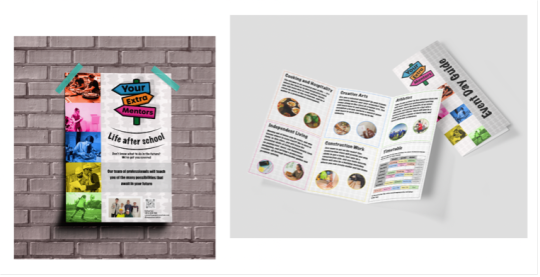

youtube
For week 11, we mainly focused on completing the promotional aspects for the protypes of the event/company. We each allocated roles for the video, edited by Jim, and portrayed the different mentors for each subject we are focusing on. We filmed around the university and had scripts to push the marketing strategy even further and make it look realistic. We also took photos for the website created by Jordann, creating little profiles for each professional. These were also used as the social media advertising created by Frank. I also took this time to change and complete the poster and pamphlet, making the design ideas mire sophisticated and easy to understand. This week was full of the promotional aspects, while Mel and Tilly completed more research and started to form the final presentation. We each took our roles in this assessment and acted upon them fast to finalise the idea pitch and concept, creating a cohesive solution through thinking methods.
0 notes
Text




This week was mainly getting us prepared for the main presentation for Assessment 2. We had to pull focus to the end goal and work hard to complete essential jobs to take the design thinking model to the next level. Jordann created an additional user journey map using the provided resources to show the perspective of both the student and the teacher on the event day program. She outlined the different thoughts they may have, and how they might react. This helped us all define the focus and aim of the company and the event day while allowing us to plan the day and incorporate activities to suit all needs and educate everyone. To push these ideas further, we interviewed teachers at rural schools on our idea. Tilly helped find contacts to interview, giving us even more insight to what our event day might need and what it can mean to both students and teachers. It inspired more ideas and helped us confirm our ideas are successful and could be effective.
0 notes
Text
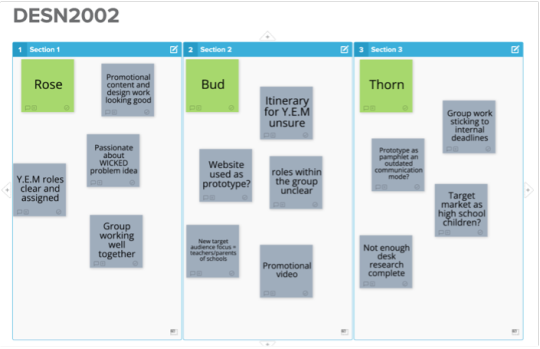
In week 9, Belinda Collins joined the tutorial to teach us of the rose, buds and thorns technique as part of the design thinking process. We participated in the activity to see what parts of out project we think is successful, what needs more research and progress on, and what we do not think is working well and how we can change it. This gave us a clear outline of what we as a group needed to push further and gain more insight on to make the initiative more effective. We all agreed that out solution to improve the quality education of disadvantaged students can work well, and that we each are passionate in our roles to make it successful. We realised we don’t have a solid itinerary planned out yet, marking it as a priority for a smooth event day to take place. We also got the idea to create a website and video for promotion and more prototypes as advertisements for the company and actual event. This method helped form new ideas, while pushing us to take the idea even further and become more effective.
0 notes
Text
In week 8, we were meant to complete the Lego activity, but due to the public holiday, we missed this tutorial. I researched and read through the article provided ‘Stage 4 in the Design Thinking Process: Prototype’ by Rikke Friis Dam and Teo Yu Siang to gain more insight with the design thinking and prototyping. It outlines that “…to determine and understand how users interact with the product…test how the users interact with the product” pushing me and my group to receive personal feedback on the poster iterations. After showing these to students, they told us that it looked a bit ‘childish’ and too ‘in your face’. This confirmed that the design needed to be more sophisticated and use personal knowledge of being in high school, remembering that teenagers want to be treated and respected like adults in order to take interest in something. This also taught us better understanding of the essential step of prototyping and testing to push to a better design outcome.
0 notes
Text


Week 7 was the presentations for Assessment 1, and to showcase what we have done. I explained our goal of creating and informing new opportunities for life after school, while creating interactive experiences to make it more enjoyable and intriguing. I finished the early stages of the poster design, using the logo created by Frank for the base colour palette. It was very vibrant and full of large text to gain the students’ attention. We also showcased the name of out initiative, “Your Extra Mentors”. This name is catchy and tells you straight away what we are there to do. This name worked successful with our focus and works well with print media for advertising. This week mainly gave us more feedback on what we can expand on, and what changes we can make to make the design thinking stronger.
0 notes
Text
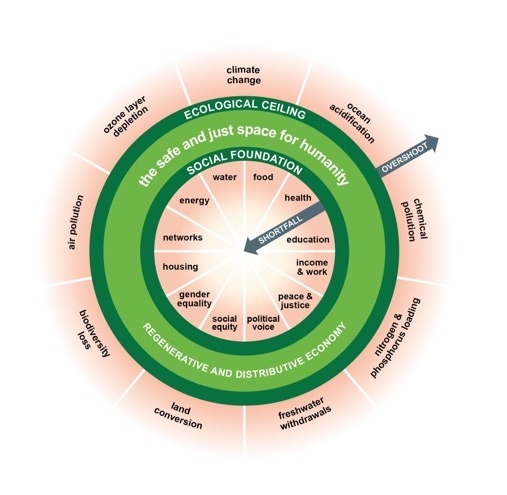
This week I missed the tutorial and exercise with Glyn Thomas, but I revised what I need to do for the presentation, as well as helping the group for form ideas. I studied the article on the “doughnut model”, as created by Kate Raworth, and thought of ideas on how this may help with putting together the ideas and be prepared for the presentation. Raworth’s model demonstrates how to put all different approaches and goals under one construction and use them together to work towards the final goal for all parties included. For our wicked problem of quality education, there’s multiple opportunities that students can undergo in the future. Our group formed the main ideas of what topics we can touch on to inspire and teach including, hospitality, independent living, creative arts, construction work and sports. Using these five key aspects of life and society, we are teaching students the different possible outcomes that they may not even have thought of, and even if an individual is not interested, they are broadening their understanding on the subject and teach them to respect others in that chosen field. These courses aim to teach and provide a base understanding of different career opportunities, for students to either aim big for, or respect others.
0 notes
Text
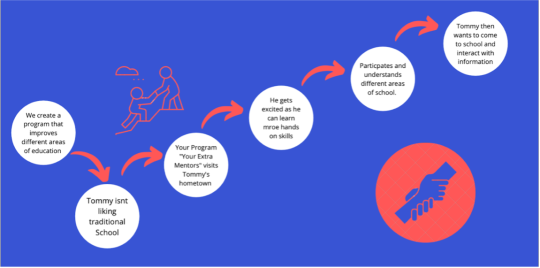
Week 5 consisted of creating a user journey map to gain a better understanding of how students may use our event, and how it can inspire them more for the future. This outlined what we can incorporate into the event so there is a wide range of activities that students can participate in. As Sam Daley highlights in his report on “Blockchain”, a system used to boost music in a ‘troubling industry’, “blockchain can re-establish the way music is produced, bought, sold, listened to and managed…” we as a team want to change the way disadvantage students see the future after school. We want them to be inspired, act upon, work towards and strive in a chosen profession that they enjoy, instead of believing there’s only limited options in life that blocks dreams and aspirations.
0 notes
Text
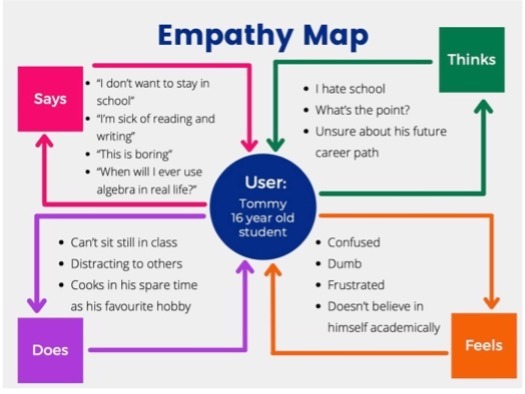

This week was focusing on research and forming the target audience of our design solution. We created an empathy map to help assist what our target is, and how we might navigate the solution to reach the needs of the individual. We each contributed to the empathy map, generating ideas that a high schooler might need to inspire them to work for their goals after school. Through this, we created a user persona to further assist in the process. We chose to aim the event at students that find it hard to focus with reading and writing, and only have one idea of what to do after school; something they are not interested in. This helped pull focus on the needs that we can aim to meet to help students.
0 notes
Text
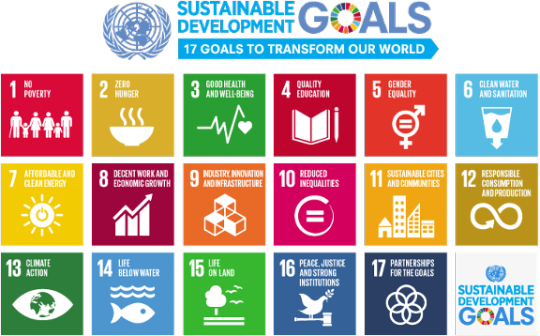
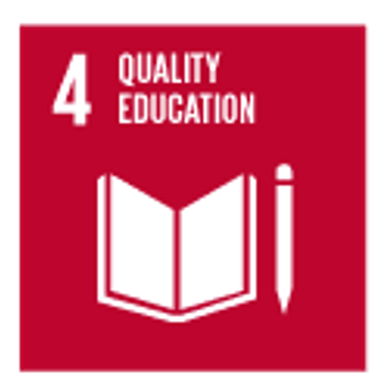
This week we tried to define our goal and start giving roles for people to complete the design solution. We decided to work towards an event or system to improve the quality of education in disadvantage areas and teach students of the many possibilities that they can achieve after school, targeting #4 of the UN Sustainable Development Goals. To keep the idea more realistic and defined, we chose to focus on rural parts of Australia as we have more personal knowledge and experience on the topic, as well as easy access to sources. We discussed different possibilities of what we could do to tackle this subject and agreed that an event day with professionals would be the most effective and easy way to approach the students’ interests. I was put in charge of creating a poster and pamphlet prototype to advertise the event, so I had to study what the best way of advertising to teenagers may be. This week formed focus on the end goal and taught us as a group to work together cohesively.
1 note
·
View note
Text

Week 2 consisted of forming my group for the assessments and find a common interest that we would want to work towards. We listened to each other’s interests in life, and what we are passionate about. This helped form a foundation of the design solution we can create for the wicked problem. We learnt about the process of inspiration, ideation, and implantation, and agreed this would be a good starting process. To keep us on track with personal experiences to create a design solution, we read Daniel Wahl’s article ‘Facing Complexity: Wicked Design Problems’ and noted that “identifying design as the activity that structures experience and expresses human intention through interactions and relationships, both materially and immaterially, can help us to become more conscious of the effects of our actions” to pull focus on a solution that we all are passionate about. We wrote down what we could work with, and what everyone was comfortable and interested in. The first main idea was education and accessibility. This became a prominent idea throughout the process, with design, nutrition, and health and wellbeing.
0 notes
Text
week 1
Week 1 of DESN2002 was the introduction to the course. I learnt what I will be studying and creating throughout the semester. The idea of ‘Design Thinking’ was already a prominent part of my practice as an individual studying design, but I realised this course will help expand the topic for myself. I understood that it will be more than just a process of design but learning how to design something for a specific audience in need. I studied the ‘Five Fundamental Processes of Design Thinking’ to try and understand how to empathise, define, ideate, prototype and test when applying design ideas. This showed that design isn’t just a creative outlet, but can have structure to create change and positivity, especially in an interactive context. This was furthered in Jeanne Liedtka’s article ‘Why Design Thinking Works’, “Organized processes keep people on track and curb the tendency to spend too long exploring a problem or to impatiently skip ahead”. I had to learn how to apply this to a ‘wicked problem’, a real-life issue. This introduction got me prepared for the course and taught me new layers to design thinking.
1 note
·
View note